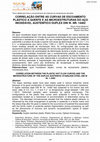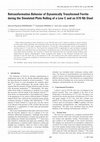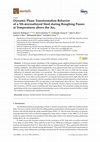Papers by Samuel Filgueiras Rodrigues
Crystals
We studied the dispersion diagram of a 2D magnetoelectroelastic phononic crystal (MPnC) with Kago... more We studied the dispersion diagram of a 2D magnetoelectroelastic phononic crystal (MPnC) with Kagomé lattice. The MPnC is composed of BaTiO3–CoFe2O4 circular scatterers embedded in a polymeric matrix. The improved plane wave expansion (IPWE) approach was used to calculate the dispersion diagram (only propagating modes) of the MPnC considering the classical elasticity theory, solid with transverse isotropy and wave propagation in the xy plane. Complete Bragg-type forbidden bands were observed for XY and Z modes. The piezoelectric and the piezomagnetic effects significantly influenced the forbidden band widths and localizations. This investigation can be valuable for elastic wave manipulation using smart phononic crystals with piezoelectric and piezomagnetic effects.
Boletín de la Sociedad Española de Cerámica y Vidrio
Journal of Materials Research and Technology
Tecnologia em Metalurgia Materiais e Mineração
The occurrence of dynamic transformation of ferrite (DTF) above Ae3 has recently been proven to b... more The occurrence of dynamic transformation of ferrite (DTF) above Ae3 has recently been proven to be an operative mechanism during hot deformation. This work is a preliminary description of the effects of DTF on the thermo-mechanical control processing (TMCP) in hot rolling of steels and a summary TMCP strategies is presented. The occurrence of dynamic transformation of ferrite in the austenite region is proved by means of synchrotron light diffraction methods. This phase transformation mechanism is taken into consideration and its effects on TMCP are proposed.

Tecnologia em Metalurgia Materiais e Mineração
When austenite is deformed above the Ae 3 temperature, partial amount of it transforms dynamicall... more When austenite is deformed above the Ae 3 temperature, partial amount of it transforms dynamically into ferrite by a displacive mechanism. After unloading, it retransforms back into the stable austenite by a diffusional process. This phenomenon influences the rolling load, which either decreases under isothermal rolling condition or does not progressively increase with decreasing temperature during cooling. In this work, plate rolling simulations employing isothermal and continuous cooling conditions were carried out on a 0.09 wt.% Nb X-70 steel. Pass strains in the range of 0.2-04, interpass times between 10-30 s and strain rate of 1s-1 were employed. The results showed that the critical strains for the initiation of dynamic transformation fell around 0.06 while the critical strain for dynamic recrystallization was 0.12. Under cooling conditions, the ferrite formation is favored as the temperature approaches the Ae 3 line. Such ferrite forms when the driving force for dynamic transformation is higher than the total free energy barrier. Increasing the holding time after rolling increases the amount of austenite available for microstructure control on subsequent stages. The dynamic transformation (DT) mechanism can be used to design improved rolling schedules.

Metals and Materials International
The correlation between hardening and softening in an ASTM F-1586 stainless steel used as biomate... more The correlation between hardening and softening in an ASTM F-1586 stainless steel used as biomaterial was investigated by means of hot torsion simulations. Multi-pass deformation under continuous cooling was employed to simulate industrial hot rolling. Samples were subjected to 17 deformation passes of strains of 0.20 and 0.30, strain rate of 1.0 s −1 in a temperature range of 1250 to 930 °C. Interpass times (t p) of 5.0, 10, 20, 40, and 80 s were used. The obtained results showed direct dependence of the mean flow stress (MFS) and all applied thermomechanical parameters. The work hardening rate associated with the degree of stress accumulation (Δσ) inhibited the metadynamic recrystallization. This led to the variation of the non-recrystallization temperature (T nr), associated with intense static recovery in the material. From the experimental data, a constitutive function of the mean flow stress (MFS) obtained through multiple nonlinear regression technique was proposed. The study aimed to have a better understanding of the physical metallurgy behind the thermomechanical behavior of the steel under a multi-pass process. The results allowed to monitor the recrystallized fraction (X) and the grain size (d) during the simulated conditions.
Journal of Materials Research and Technology

ABM Proceedings
An austenitic stainless steel ISO 5832-9 was deformed in a torsion test machine over the temperat... more An austenitic stainless steel ISO 5832-9 was deformed in a torsion test machine over the temperature range of 1,000°C-1,200°C and strain rates of 0.05, 0.1, 1.0 and 5.0s-1. The Steel plastic behavior was studied by analyzing the flow curves shapes and using the constitutive equations under the conditions of thermomechanical treatment. The curves initially presented an increase in stress characterized by hardening work, followed by a drop in stress to an intermediate level that reached or not, for certain conditions, the steady state softening. The plastic flow curves of ISO 5832-9 steel displayed in three different ways: (i) Curves with continuous softening presenting plastic instability for low temperatures and high strain rates; (ii) curves type flat, here after the peak there is little variation of stress with strain presenting softening mechanism by higher contribution of dynamic recovery at low temperatures and low and intermediate strain rates; (iii) curves with softening after the critical deformation favored by high temperatures and low strain rates. These behaviors indicate the influence of the stacking fault energy (SFE) and precipitated particles on the softening kinetics of this steel.

ABM Proceedings
Resumo Os aços inoxidáveis dupex tem sido largamente empregado em vários setores da industria pri... more Resumo Os aços inoxidáveis dupex tem sido largamente empregado em vários setores da industria principalmente em virtude da sua boa combinação entre suas propriedades mecânicas e resistência a corrosão. Um aço inoxidável duplex DIN W. Nr. 14462 foi submetido a ensaios de torção a quente com taxas de deformação de 0,3; 0,5; 1; 3 e 5 s-1 a temperaturas que variou entre 1.000 e 1.150°C. As amostras deformadas foram analisas através de microscopia ótica. As configurações das curvas de escoamento plástico foram analisadas em termos dos parâmetros de fluxo localizado como um mecanismo de acomodação da deformação durante a torção a quente. As microestruturas reveladas mostraram que o comportamento plástico do material é influenciado pela disposição inicial das partículas de austenita na matriz ferrítica e a queda de tensão após o pico esta relacionada à ocorrência de fluxo localizado na matriz ferrítica associado à fragmentação das partículas de austenita durante o processamento, bem como aos fenômenos de recuperação e recristalização dinâmica, típicos dos aços inoxidáveis duplex. Palavras-chave: aços inoxidáveis duplex; curvas de escoamento plástico; microscopia ótica.

ISIJ International, 2017
Plate rolling simulations were carried out on an X70 Nb steel by means of torsion testing. A seve... more Plate rolling simulations were carried out on an X70 Nb steel by means of torsion testing. A seven-pass rolling schedule was employed over the finishing temperature range 950-860°C with 15 degrees of cooling between passes. Interpass intervals of both 10 and 30 seconds were employed, which corresponded to cooling rates of 1.5 and 0.5°C/s, respectively. The mean flow stresses (MFS`s) applicable to each schedule increased less rapidly than expected from the decreases in temperature. This indicated that both dynamic transformation (DT) and dynamic recrystallization were taking place during straining. The volume fractions of DT ferrite formed were determined by optical metallography and increased with pass number. Shorter interpass times also favored the formation and retention of ferrite as did the approach of the Ae 3. The simulations indicate that ferrite is unavoidably produced during plate rolling and this decreases the amount of austenite available for microstructure control on subsequent cooling.

Materials Research, 2017
This study investigated the softening mechanisms of the AISI 410 martensitic stainless steel duri... more This study investigated the softening mechanisms of the AISI 410 martensitic stainless steel during torsion simulation under isothermal continuous in the temperature range of 900 to 1150 °C and strain rates of 0.1 to 5.0s-1. In the first part of the curves, before the peak, the results show that the critical (ε c) and peak (ε p) strains are elevated for higher strain rate and lower temperatures contributing for higher strain hardening rate (h). Moreover, this indicated that dynamic recrystallization (DRX) and dynamic recovery (DRV) are not effective in this region. After the peak, the reductions in stresses are associated to the different DRX/DRV competitions. For lower temperatures and higher strain rates there is a delay in the DRX while the DRV is acting predominantly (with low Avrami exponent (n) and high t 0.5). The steady state was reached after large strains showing DRX grains, formation of retained austenite and the presence of chromium carbide (Cr 23 C 6) and ferrite δ at the martensitic grain boundaries. These contribute for impairing the toughness and ductility on the material. The constitutive equations at the peak strain indicated changes in the deformation mechanism, with variable strain rate sensitivity (m), which affected the final microstructure.

ISIJ International, 2017
Plate rolling simulations were carried out on an X70 Nb and a low C steel by means of torsion tes... more Plate rolling simulations were carried out on an X70 Nb and a low C steel by means of torsion testing. A seven-pass rolling schedule was employed where the last pass was always applied above the respective Ae 3 temperature of the steel. Interpass intervals of 10 and 30 s were employed, which corresponded to cooling rates of 1.5 and 0.5 C/s. The mean flow stresses (MFS`s) applicable to each schedule increased less rapidly than expected from the decreases in temperature due to the dynamic transformation (DT) that took place during straining. The amounts of ferrite that retransformed into austenite during holding were determined by optical metallography. These increased with length of the interpass intervals and were reduced in the X70 steel due to the presence of Nb. The holding times after rolling required to increase the amount of austenite available for microstructure control on subsequent cooling were also determined for the two steels.

ISIJ International, 2017
Torsion simulations of plate rolling were carried out on an X70 steel at 900°C; pass strains of 0... more Torsion simulations of plate rolling were carried out on an X70 steel at 900°C; pass strains of 0.4 and a strain rate of 1 s − 1 were employed together with interpass times of 1.0 s, 10.0 s, 20.0 s and 30.0 s. The mean flow stresses (MFS`s) applicable to each pass were calculated by integration of the individual flow curves. These decreased with pass number, indicating that both dynamic transformation and dynamic recrystallization were taking place during straining. The critical strains for the initiation of dynamic transformation were determined by double differentiation and fell in the range 4-5% from the second to the last pass. The volume fraction of dynamically formed ferrite retained after a simulated rolling pass decreased with interpass time. This was due to the increased amount of ferrite retransformed into austenite during the longer interpass times. The forward transformation is considered to occur displacively while the retransformation into austenite during holding takes place by a diffusional mechanism.

Materials Research, 2016
The aim of this work is evaluate the influence of welding conditions on abrasive wear resistance ... more The aim of this work is evaluate the influence of welding conditions on abrasive wear resistance in coating of Fe-Cr-C. The metal base used in this investigation was the steel SAE 1020 and as welded metal the selfshilded tubular wires of Fe-Cr-C with 1.6 mm of diameter. The welding parameter such as amperage, voltage, welding speed, wire feed speed and the distance between the point and samples were kept constant by varying the electrode inclination and the number of layers deposited. These resulted in four different weld conditions: pulling and pushing the weld pool and hardfacing formed with 1 end 2 layers. Their influences on dilution, microhardness and microstructure were evaluated and correlated with the abrasive wear according to the standard tests methods for abrasion measurements through the usage of dry sand/rubber wheel apparatus, ASTM G-65-04. The results showed that the wear resistance of the four different conditions was affected by dilution, microstructure morphology and carbide volume fraction. The best conditions for hardfacing deposition were for pushing the torch and two layers added.

Metals
A five-pass torsion simulation of the roughing passes applied during hot plate rolling was perfor... more A five-pass torsion simulation of the roughing passes applied during hot plate rolling was performed in the single-phase austenite region of a Nb-microalloyed steel under continuous cooling conditions. The deformation temperatures were approximately half-way between the Ae3 and the delta ferrite formation temperature (i.e., 250 °C above the Ae3) in which the free energy difference of austenite and ferrite is at maximum. The microstructures in-between passes were analyzed to characterize and quantify the occurrence of deformation-induced dynamic phase transformation. It was observed that about 7% of austenite transforms into ferrite right after the final pass. The results are consistent with the calculated critical strains and driving forces which indicate that dynamic transformation (DT) can take place at any temperature above the Ae3. This mechanism occurs even with the presence of high Nb in the material, which is known to retard and hinder the occurrence of DT by means of pinning...

Materials Science and Engineering: C, 2015
Precipitation-recrystallization interactions in ASTM F-1586 austenitic stainless steel were studi... more Precipitation-recrystallization interactions in ASTM F-1586 austenitic stainless steel were studied by means of hot torsion tests with multipass deformation under continuous cooling, simulating an industrial laminating process. Samples were deformed at 0.2 and 0.3 at a strain rate of 1.0 s −1 , in a temperature range of 900 to 1200°C and interpass times varying from 5 to 80 s. The tests indicate that the stress level depends on deformation temperature and the slope of the equivalent mean stress (EMS) vs. 1/T presents two distinct behaviors, with a transition at around 1100°C, the non-recrystallization temperature (T nr ). Below the T nr , strain-induced precipitation of Zphase (NbCrN) occurs in short interpass times (t pass b 30 s), inhibiting recrystallization and promoting stepwise stress build-up with strong recovery, which is responsible for increasing the T nr . At interpass times longer than 30 s, the coalescence and dissolution of precipitates promote a decrease in the T nr and favor the formation of recrystallized grains. Based on this evidence, the physical simulation of controlled processing allows for a domain refined grain with better mechanical properties.

A interação recristalização-precipitação no aço inoxidável austenitico ISO 5832-9 foi estudada po... more A interação recristalização-precipitação no aço inoxidável austenitico ISO 5832-9 foi estudada por testes de torção a quente com múltiplas deformações em resfriamento continuo. As amostras foram deformadas a 0,2 e 0,3 com taxa de deformação de 1,0 s -1 , intervalo de temperatura de 900 a 1200 o C e tempo entre passe variando de 5 à 80 s. Os testes mostram que o nível de tensão depende da temperatura de deformação e a inclinação da tensão média equivalente (TME) vs. 1/T apresentam dois diferentes comportamentos, com transição em torno de 1100 o C, temperatura de não recristalização (Tnr). Abaixo da Tnr, com tempo entre passe curto (tp < 40s), ocorre precipitação da fase Z (NbCrN) induzido por deformação, inibindo a recristalização e promovendo acumulo de tensão passo a passo, responsável pelo aumento na Tnr. Para tempo entre passes maiores que 30s o coalescimento e a dissolução dos precipitados provocam redução na Tnr. Com base nessas evidencias, o refinamento de grãos provocado pela processamento controlado de recristalização convencional foi avaliado.






Uploads
Papers by Samuel Filgueiras Rodrigues